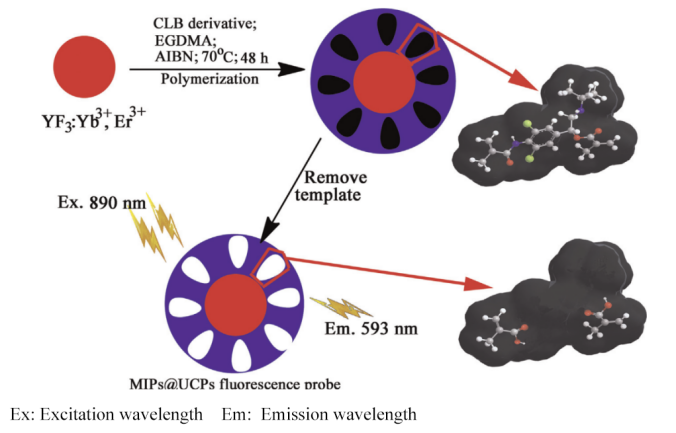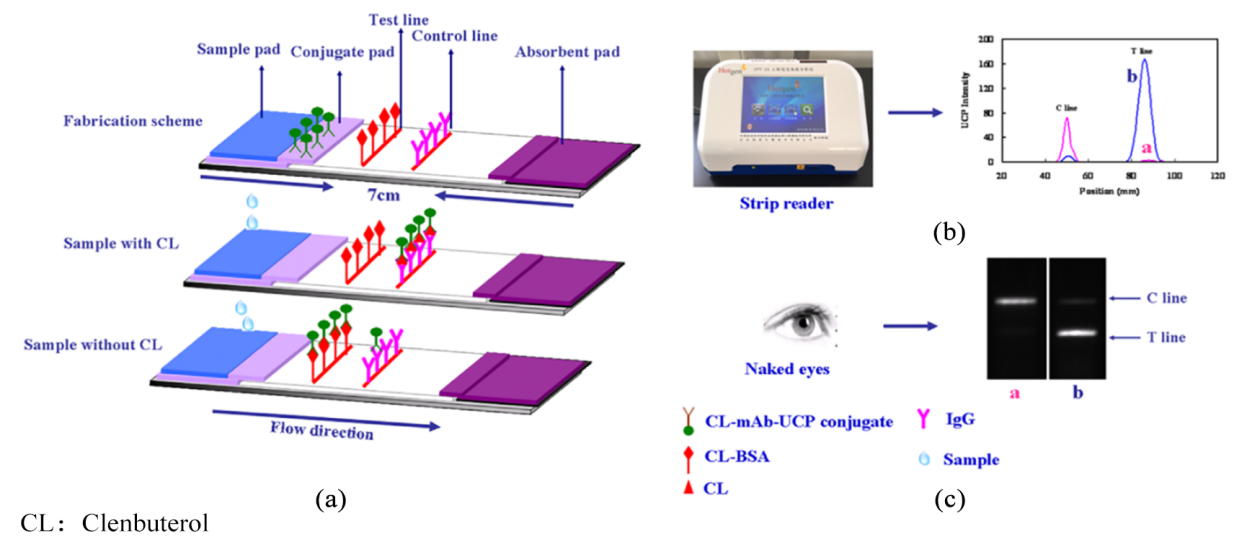1.中国农业科学院 农业质量标准与检测技术研究所,北京 100081; 2.国家纳米科学中心,北京 100190
摘要: 纳米材料具有特殊的尺寸效应和优异的光电性质,已在传感分析中得到高度重视和广泛应用,大幅提高了传感分析技术的性能。近年来,智慧农业发展迅速,农产品质量安全作为农业生产的重要组成部分,对农业传感技术的灵敏度、稳定性和检测通量等指标要求越来越高。本综述简要阐述了几种常用的纳米材料的性质和特点,包括碳基纳米材料、金属纳米材料和金属-有机框架材料等。重点论述了基于纳米材料的化学传感、生物传感、电化学传感和光谱传感等常用传感分析技术和器件,以及纳米传感分析技术在农产品质量安全,尤其在克伦特罗和三聚氰胺等危害物,甲硝唑、二噁英类化合物,违禁添加物,真菌毒素,锌、镉、铅等目标物,丙烯酰胺、呋喃类、硝基呋喃类抗生素监测等方面的应用。纳米材料的制备和修饰技术扔需要进一步提升,多目标、高通量纳米传感器件在实际应用中的价值广受关注,在线传感分析在农产品质量安全智慧监控方面有迫切需求需要快速、实时、在线监测。
关键词: 纳米材料;智慧农业;农产品质量安全;纳米传感器
中图分类号: S951.4+2; S-1 文献标志码: A 文章编号: 202003-SA003
引文格式:王培龙, 唐智勇. 农产品质量安全纳米传感应用研究分析与展望[J]. 智慧农业(中英文), 2020, 2(2): 1-10.
1 引 言
智慧农业是农业发展从数字化到网络化再到智能化的高级阶段,对农业具有里程碑意义,已成为世界现代农业发展趋势,也成为发展中国家消除贫困的重要途径。传感技术在智慧农业中扮演了重要角色,是智慧农业的核心与关键。未来国际农业传感技术的突破和颠覆主要集中在动植物生命信息捕获、种养殖加工储运环境信息传感和农产品质量安全传感等几个方面[1]。
随着物质生活的极大丰富,消费者对高品质农产品的需求日益增长,农产品质量安全传感分析技术也越来越受到重视。影响农产品质量安全的危害因子主要有人为因素(如非法添加、农药和兽药使用等)、自然污染(如真菌毒素、致病微生物等)和环境迁移(如重金属、持久性有机污染物等)[2]。这些危害因素种类多、危害性强且含量低,而农产品具有“鲜活”特性,对保障其质量安全传感分析技术的灵敏度、稳定性和选择性等性能指标和可操作性、实用性等提出了更高要求。现有农产品质量安全传感分析技术难以满足现代农业的需求。
纳米传感器是一种具有纳米尺度特征尺寸的传感器,有无损性、微创性和实时性等特点,已成为农业生产中营养管理、疾病评估、食品生产、DNA/蛋白质检测和植物激素调控等的重要工具[3]。纳米材料的出现为农产品质量安全传感分析性能提升和改进提供了新机遇。由于纳米材料特殊的尺寸效应、表面效应和宏观量子隧道效应,显示出光学、热学、电学、磁学、力学以及化学方面的特殊性质。纳米材料的这些特性对于改进和提升农产品质量安全传感分析性能具有重要意义。目前,碳基纳米材料、贵金属纳米材料以及金属有机框架等纳米结构材料等已在构筑高性能农产品质量安全纳米传感器件方面广泛应用,表现出极为优异的性能。
本文重点围绕农产品质量安全传感分析技术进行综述,首先简要介绍纳米材料的类别和性质,然后重点论述纳米材料在农产品质量安全传感分析技术,如化学传感、生物传感、电化学传感以及光谱传感中的应用。最后,对纳米材料在农产品质量安全传感分析中的应用进行了总结和展望。
2 纳米材料及其性质
纳米材料主要包括纳米尺寸材料和纳米结构材料,具体是指在三维空间中至少有一维处于纳米尺寸(0.1~100 nm)或由它们作为基本单元构成的材料。由于纳米材料的尺寸、表面和宏观量子隧道等效应,使其具有特殊的光、电、磁等理化性质,在组装传感器件方面具有特定优势。目前,在纳米传感中常用的纳米材料包括碳基纳米材料(Carbon-based Nanomaterials,CNMs)、金属纳米材料和金属-有机框架材料(Metal-Organic Frameworks,MOFs)等。
CNMs是一类工程纳米材料,因其优异的光、电、机械和热性能,在能源、催化、环境和生命科学等领域得到了广泛应用[4]。继1985年发现富勒烯(C60)碳纳米材料后,1991年发现碳纳米管(CNT),2004年发现石墨烯和碳量子点。目前,这些碳纳米材料作为传感器的信号放大和传输单元,已在环境监测、食品安全等领域得到了很好的应用[5,6]。
近几十年来,纳米科学和技术的迅速发展促进了对金属纳米材料的合成、性能和应用的深入研究[7]。大量具有明确尺寸、形状和组成的金属和合金纳米材料已被合成用于电子、催化和生物医学等领域。特别是贵金属纳米材料,因其源于材料表面强电磁作用的光学特性更为引人注目,这些光学特性可用于构筑可视化传感和增强光谱信号
[2]。
MOFs是一类具有均匀结构的复杂化多孔材料,由于其高孔隙率和可调的物理和化学性质,被用于气体和水储存、气体净化、污染物去除和催化等领域。MOFs光谱、结构等特性和丰富的活性基团,使其在传感分析领域具有广阔的应用前景[8]。
3 农产品质量安全纳米传感及应用
3.1 化学传感
化学传感器件是对各种化学物质敏感并将其浓度转换为电信号的器件,并进行检测。具有响应速度快、灵敏度高等特点,在环境监测、食品安全和医疗诊断[9]等领域广泛应用。纳米材料被集成到传感系统中,具有更高的灵敏度、更短的检测时间和更好的分析通量。如Liao等[10]研发了一种用于压力/温度/紫外检测的高伸缩性ZnO纤维多功能纳米传感器,可以同时实现多指标的传感分析。Feng等[11]采用静电纺丝工艺制备的非晶碳/还原氧化石墨烯(rGO)包裹的Co3O4纳米纤维,能够对NH3进行选择性传感监测,有良好的灵敏度和快速响应(约20 s,50 mg/L)能力,并具有长达4年的长期稳定性。
化学传感器件在农产品质量安全监测中具有明显的优势,但是农产品样品基质复杂且目标物含量较低,因此需要选择性的材料进行识别。分子印迹聚合物(Molecular Imprinted Polymer,MIP)是一种良好的识别材料,结合纳米标记材料能够开发一系列化学传感器。基于MIP包被CdTe量子点(MIP-CdTeQDs),Huy等[12]建立了一种克伦特罗和三聚氰胺等危害物的传感分析新方法,其检测限为120 ng/mL。通过对牛奶和动物肝脏样品中克伦特罗和三聚氰胺的检测分析,评价了该方法在实际样品中的可行性,回收率为92%~97%。特别是MIP-CdTeQDs传感器件可以很容易地再生,用于后续的样品分析。同样,Tang等[13]提出了一种基于MIPs和上转换发光纳米材料(UCP)的光谱传感器制作新策略(见图1)。他们合成了一种基于UCPs(YF3:Yb3+或Er3+)的MIPs@UCPs上转换发光探针,通过分子印迹聚合物(MIPs@UCPs)对目标物进行了选择性识别,依据发光强度变化实现对目标物的传感分析,对克伦特罗的检测限低于0.12 μg/L。Mehrzad-Samarin等[14]报道了一种用于检测生物样品中甲硝唑的新型光学纳米传感器合成了石墨烯量子点嵌入二氧化硅分子印迹聚合物(GQDs-embedded-SMIP)作为甲硝唑选择性荧光探针。新合成的嵌入SMIP的量子点在450 nm处有较强的荧光发射,在365 nm处激发,在甲硝唑作为模板分子存在下猝灭,猝灭效率与甲硝唑浓度成正比,检测限为0.15 μmol/L。
纳米材料的性质以及与目标分析物的特异作用,也能提高化学传感的稳定性和选择性。近年来,中国农业科学院“饲料质量安全检测与评价”研究团队应用多孔发光MOFs材料创制了系列可再生纳米传感新材料,如创制了一种高稳定的锆基MOF材料Zr6O4(OH)8(HCOO)2(CPTTA)2,(BUT-17)该MOF材料具有一维六边形通道和富含苯基的孔表面,用于识别和传感两种具有代表性二噁英类化合物,多氯二苯并二噁英(BCDD)和2,3,7,8-四氯二苯并二噁英(TCDD)。基于二噁英类化合物对BUT-17的荧光猝灭研制了传感新器件,其对BCDD和TCDD的检测限分别为27 μg/L和57 μg/L,且具有很强的选择性,不受类似化合物的干扰[15]。类似地,团队还建立了违禁添加物[16]和禁限用药物[17]的传感方法。另外,Qiu等[18]将硝基苯基引入一种能形成多孔晶体带的三氟芴分子中,研制了一种新型的高灵敏度邻苯二甲酸酯(塑化剂)荧光传感器。在单晶分析和理论计算的基础上,证明了邻苯二甲酸酯分子可以通过非共价相互作用扩散到晶体带的空穴中,有效地抑制硝基苯基的旋转,从而增强了发射。由于这种新的响应机制,邻苯二甲酸酯的荧光检测具有高灵敏度,邻苯二甲酸二(2-乙基己基)酯(DEHP)的检测限为0.03 μg/L,而且该纳米传感器具有快速可逆开启的特点,可用于食品包装材料的在线监测。

图1 MIPs@UCPs上转换发光探针传感机理[13]
Fig. 1 Sensing mechanism of luminescent probe of MIPs@UCPs
近年来,比色传感器因其便于肉眼判定和简单操作而受到越来越多的关注。溶液中的金基纳米材料(AuNMs)聚集或刻蚀后,在可见光区域呈现不同的颜色和光谱变化。利用AuNMs这一特性,通过目标分析物与AuNMs表面的静电作用和氢键等非共价力,实现目标分析物的可视化传感。这种比色传感最大的优点是无需设备,肉眼可判[19]。比色传感已很好地用于医学和食品安全领域中病毒[20]、DNA[21]、小分子[22]、金属离子[23]和癌细胞[24]
等目标物的检测。Zhou等[25]采用三聚氰胺修饰的金纳米粒子(AuNPs)对莱克多巴胺和沙丁胺醇进行了高选择性和高灵敏度的比色检测。此类β-激动剂化合物的存在通过氢键作用诱导金纳米粒子的聚集,伴随着AuNPs溶液颜色和光学性质的明显变化,可通过肉眼对目标物监测。
3.2 生物传感
生物传感通常应用生物识别单元如抗体、适配体等进行组装传感器件,纳米材料在生物传感中主要起信号标记和增强作用。目前,生物传感器件已广泛应用于农产品质量安全中违禁添加物、真菌毒素等的监测。AuNPs常用于标记抗体来制作胶体金试纸条,在抗生素、β-受体激动剂和黄曲霉毒素等的快速筛查和监测中广泛应用[26]。如Wu等[27]应用AuNPs结合金刚烷胺抗体建立了一种灵敏的胶体金免疫层析方法,用于快速半定量检测鸡肌肉中金刚烷胺,检测时间为12 min,检测限为1.80 ng/mL。Song等[28]应用AuNPs和单克隆抗体建立一种高灵敏度、特异性的牛奶中常山酮(HFG)快速传感分析方法,对牛奶中常山酮的检出限为100 ng/mL,整个检测过程可在5 min内完成。
近年来,为了获得更高的传感灵敏度,一些新型纳米标记材料,如荧光纳米材料和上转换纳米材料等,被应用于生物传感中抗体标记。Ren等[29]应用CdSe/ZnS发光量子点标记抗体研究建立了玉米中黄曲霉毒素B1超高灵敏度传感分析方法,检测限为0.42 pg/mL,较常规AuNPs标记方法的灵敏度提升2个数量级。Wang等[30]应用荧光纳米微球标记单克隆抗体组装了同时测定克伦特罗、莱克多巴胺和沙丁胺醇等3种“瘦肉精”类化合物的免疫层析传感器,实现了从单一目标向多目标同时检测的转变。进而结合高交叉反应率抗体,研制出能够同时测定7种“瘦肉精”类化合物的传感分析方法[31]。为了消除样品基质干扰,提高检测的准确度,Wang等[32]利用上转换发光(Up-conversion Phosphor,UCP)纳米材料低能量激发和高能量发射的特性,建立了UCP纳米微球标记侧流层析传感器件,能够对动物性食品中瘦肉精类化合物克伦特罗进行超敏检测(见图2)。由于UCP纳米材料的光谱特性,很好地消除了复杂样品基质的干扰。

图2 UCP纳米材料标记免疫传感机理[32]
Fig. 2 Sensing mechanism of UCP labeled immunoassay
近年来,除传统的抗体外,适配体的良好识别和选择性结合能力也得到关注。针对农产品中危害物,相关机构应用适配体结合纳米材料,研发了系列生物传感器件。Ma等[33]将铂纳米粒子(PtNPs)包埋在AFB1响应性DNA水凝胶中,开发基于微压传感器平台的AFB1便携式生物传感器。Hu等[34]选择HKUST-1 MOF材料作为吸附剂制备Fe3O4/g-C3N4/HKUST-1复合纳米材料,构筑了赭曲霉毒素A(Ochratoxin,OTA)生物传感器。因为HKUST-1可以提高复合材料的化学稳定性,并通过光诱导电子转移(Photo-induced Electron Transfer,PET)完全熄灭OTA适配体上5-羧荧光素(FAM)染料的荧光。因此,在OTA存在下,识别适体可以与OTA结合,从Fe3O4/g-C3N4/HKUST-1复合物中释放出相应的FAM标记的适体,从而使传感系统的荧光强度逐渐恢复。反之,荧光被猝灭。该生物传感器灵敏度达2.57 ng/mL。
3.3 电化学传感
电化学(Electrical Conductivity,EC)传感器是一种典型的具备微型化分析设备,通过测量电流等电化学信号的变化来检测痕量的目标,包括有机小分子、金属离子和生物分子。由于化学/生物分子在电极和电化学单元的作用下氧化/还原而产生的电压、电位或阻抗信号。一般来说,电极的修饰主要是通过结合特定的识别元件来提高传感器的选择性,如适体、抗体和受体等[35]。目前,EC传感在农产品中危害物的检测中越来越受到重视。
纳米材料在提升EC传感性能方面扮演着重要的角色。Rivas等[36]开发了一种基于IrO2纳米颗粒的纳米结构平台,以提高EC的分析性能。在复杂样品中检测OTA时,基质背景干扰较低,说明了该方法在实际样品分析中的有效性。作者团队应用AuNPs和石墨烯开发了无标记EC传感新技术,结合抗体和适配体,实现了对莱克多巴胺等养殖过程非法添加物的快速、高敏检测,检测灵敏度为1.0×10-12 mol/L[37,38](见图3)。Yang等[39]报道了一种基于量子点发光EC传感器,通过外切酶催化靶循环放大大幅提高了检测灵敏度,对OTA检测灵敏度达到0.64 pg/mL。
丝网印刷技术(Screen-Printed Electrodes,SPE)是EC传感器制备的前沿技术之一,使EC传感器能够更方便用于各种分析。然而,根据EC的特殊用途,选择纳米材料作为SPEs基材非常重要
[40]。碳纳米材料或改性碳纳米材料,如石墨烯[41]、石墨[42]、富勒烯[43]和碳纳米管(CNTs)[44],是SPE最常用的基材。这些纳米材料对EC传感器产生了巨大的影响[45],能够提高生物分子的固定化效率和加速电极表面的电荷转移速率。此外,可以增加EC中介以放大来自SPEs的信号和实现多目标分析[46]。Chaiyo等[47]用Nafion/离子液体/石墨烯复合物作为基材,通过SPE技术制备EC传感器,能够同时检测锌、镉、铅等目标物。
纳米结构的MOFs材料(nMOFs)在检测各种目标物的传感领域中具有广泛的应用潜力,因而受到越来越多的关注[48]。此外,nMOFs有机配体上的特殊官能团可通过π-π堆积、氢键和静电力,与带负电荷的核酸序列之间发生作用,从而更有利于构建高性能传感界面[49]。目前,已有研究人员通过nMOFs与适配体结合开发系列EC传感器[50]。Liu等[51]提出了一种基于类似Zr-MOFs的可调谐EC用于蛋白质检测,具有较高的灵敏度、良好的重复性和在实际样品中的适用性。随后,同一组人通过一锅法制备了嵌入Au纳米团簇的2D Zr-MOFs纳米片(2D AuNCs@521-MOF)[52],能够对可卡因进行超敏检测。

图3 无标记EC传感机理[37,38]
Fig. 3 Sensing mechanism of label free EC sensors
3.4 光谱传感
光谱传感中拉曼光谱的灵敏度最好,本文重点介绍表面增强拉曼光谱(Surface-enhanced Raman Spectroscopy,SERS)及其应用。SERS是入射光激发纳米尺度贵金属材料产生的一种拉曼散射增强效应,可实现对单分子的高灵敏“指纹”识别。SERS技术具有良好的灵敏度、单分子检测能力和丰富的光谱信息等优点,在目标物快速传感分析中成为一种很有前途的光谱技术[53],在食品安全[54]、环境监测[55]和健康[56]等领域迅速发展。
SERS分析中,光谱信号增强是其中关键和核心[57]。纳米材料在SERS信号增强方面的优势已得到验证,并获得良好的分析结果。作为典型的AuNMs,AuNPs和金纳米棒(AuNRs)具有可见光激发的局部表面等离子共振(Localized Surface Plasmon Resonance, LSPR)特性,可以集中局部电磁场[58],提高SERS检测信号和检测灵敏度。Cheng等[59]应用二次氧化石墨烯与AuNPs结合,实现了油炸食品中丙烯酰胺的高敏检测,检测灵敏度达到2.0 μg/kg。Alsammarraie 和Lin[60]应用AuNRs阵列增强西维因农药残留,实现对牛奶和水果中西维因残留的检测,检测灵敏度达50 μg/kg。多目标同时传感分析是SERS的特点,Xie等[61]开发了AuNPs增强SERS信号,快速检测呋喃类抗生素(包括呋喃丹、呋喃他酮及其混合物)的方法。用平均粒径为50 nm的AuNPs活性SERS基底研究了对硝基呋喃类抗生素信号增强效果,建立了硝基呋喃类化合物的SERS传感分析方法。在最佳条件下,LOD可达到5.0 μg/kg。
近年来,一些基于MOFs修饰AuNMs的小分子SERS检测方法得到了发展。MOFs材料的多孔性对目标分析物能够更好的富集,同时能够保证纳米材料的稳定性。如He等[62]成功制备了核壳型Au@MOF-5纳米结构,其中单个AuNP核被均匀的MOF-5壳包裹。与裸AuNPs和纯MOF-5微球相比,壳厚为(3.2±0.5)nm的核壳Au@MOF-5纳米结构对CO2具有独特的SERS活性(见图4)。Hu等[63]将AuNP嵌入的MOFs(MIL-101)进行高灵敏度的SERS检测。新的SERS底物对多种不同的目标分析物具有高度的敏感性、稳定性和亲和性,罗丹明6 G和苯扎定的LOD分别为41.75 fmol和0.54 fmol。由于MOFs具有保护壳,该底物还表现出高稳定性和重复性,以及分子筛效应。

图4 不同厚度MOF-5包被贵金属的光谱信号增强材料的电镜图[62]
Fig. 4 Scanning electron microscopy (SEM) and transmission electron microscopy (TEM) (inset) images of core-shell Au@MOF-5 nanostructures with shell thicknesses
4 存在的问题与展望
目前,纳米传感在农产品质量安全监测领域广泛应用并具有良好的前景。纳米材料是纳米传感的基础,也是实现纳米传感的灵敏度、稳定性和可靠性等分析性能的关键。尽管纳米传感发展迅速,但仍有一些瓶颈问题需要解决。
首先,纳米材料的制备和修饰技术需要进一步提升,以获得性能更优和更加稳定的功能性纳米材料。如贵金属纳米材料形貌与其LSPR性质有密切的关联性,如何精确控制纳米材料形貌,获得具有理想LSPR性能的贵金属纳米材料,需要进一步解决。近年来,MOFs材料的特殊性质和优异性能越来越受关注,但MOFs材料的稳定性和可控多级孔的获得仍是困扰其应用的难题。
其次,多目标、高通量纳米传感器件在实际应用中的价值广受关注。尽管科研人员已经开发出系列高通量纳米传感分析技术和器件,但在保证分析性能的前提下,不同种类化合物同时进行传感分析,更高的分析通量,仍然是一个瓶颈。需要在纳米传感器件的构筑方面努力。
最后,在线传感分析在农产品质量安全智慧监控方面有迫切需求,特别是农产品生产链条长,具有“鲜活性”的特性,需要快速、实时、在线监测。但受纳米传感器件的再生性限制,难以实现在线传感分析。因此,需要在纳米材料和纳米技术以及纳米传感器件构筑方面获得突破。
通过解决上述纳米材料精控制备和纳米传感器件构筑中的瓶颈问题,纳米传感在农产品质量安全中的应用会得到迅速发展。更重要的是利用纳米材料和纳米技术制作传感器,是立足于原子尺度操控,从而极大地丰富了传感理论,提升了传感器的制作水平,拓宽了传感器的应用领域。未来,随着纳米材料制备技术的成熟,农产品质量安全纳米传感器的尺寸更小、检测精度更高,纳米传感器的构筑向集成化、智能化方向发展,传感性能向宽量程、高精度、强抗干扰、长寿命和可重复利用的方向发展。
参考文献:
[1] FRACETO L F, GRILLO R, DE MEDEIROS G A, et al. Nanotechnology in agriculture: Which innovation potential does it have?[J]. Front. Environ. Sci., 2016, 4: ID 20.
[2] WANG P, LIN Z, SU X, et al. Application of Au based nanomaterials in analytical science[J]. Nano Today, 2017, 12: 64-97.
[3] KWAK S Y, WONG M H, LEW T T S, et al. Nanosensor technology applied to living plant systems[J]. Annual Review of Analytical Chemistry, 2017, 10(1): 113-140.
[4] MUKHERJEE A, MAJUMDAR S, SERVIN A D, et al. Carbon nanomaterials in agriculture: A critical review[J]. Frontiers in Plant Science, 2016, 7: ID 172.
[5] WANG Z, YU J, GUI R, et al. Carbon nanomaterials-based electrochemical aptasensors[J]. Biosens. Bioelectron, 2016, 79: 136-149.
[6] PAN M, YIN Z, LIU K, et al. Carbon-based nanomaterials in sensors for food safety[J]. Nanomaterials, 2019, 9(9): ID 1330.
[7] CHENG H, YANG N, LU Q, et al. Syntheses and properties of metal nanomaterials with novel crystal phases[J]. Advanced Materials, 2018, 30(26): ID 1707189.
[8] WANG P, XIE L, JOSEPH E A, et al. Metal-organic frameworks for food safety[J]. Chem. Rev., 2019, 119(18): 10638-10690.
[9] KIM S J, CHOI S J, JANG J S, et al. Innovative nanosensor for disease diagnosis[J]. Acc. Chem. Res., 2017, 50(7): 1587-1596.
[10] LIAO X, LIAO Q, ZHANG Z, et al. A highly stretchable ZnO@Fiber-based multifunctional nanosensor for strain/temperature/UV detection[J]. Advanced Functional Materials, 2016, 26(18): 3074-3081.
[11] FENG Q, ZENG Y, XU P, et al. Tuning the electrical conductivity of amorphous carbon/reduced graphene oxide wrapped-Co
3O4 ternary nanofibers for highly sensitive chemical sensors[J]. J. Mater. Chem. A, 2019, 7(48): 27522-27534.
[12] HUY B T, SEO M H, ZHANG X, et al. Selective optosensing of clenbuterol and melamine using molecularly imprinted polymer-capped CdTe quantum dots[J]. Biosens. Bioelectron, 2014, 57: 310-316.
[13] TANG Y, GAO Z, WANG S, et al. Upconversion particles coated with molecularly imprinted polymers as fluorescence probe for detection of clenbuterol[J]. Biosens. Bioelectron, 2015, 71: 44-50.
[14] MEHRZAD-SAMARIN M, FARIDBOD F, DEZFULI A S, et al. A novel metronidazole fluorescent nanosensor based on graphene quantum dots embedded silica molecularly imprinted polymer[J]. Biosens. Bioelectron, 2017, 92: 618-623.
[15] WANG B, WANG P, XIE L, et al. A stable zirconium based metal-organic framework for specific recognition of representative polychlorinated dibenzo-p-dioxin molecules[J]. Nat. Commun., 2019, 10: ID 3861.
[16] YANG H, WANG B, CHENG J, et al. Determination and removal of clenbuterol with a stable fluorescent zirconium(IV)-based metal organic framework[J]. Microchimi Acta, 2019, 186: ID 454.
[17] LYU J, WANG B, XIE Y, et al. Selective detection of two representative organic arsenic compounds in aqueous medium with metal-organic frameworks[J]. Environ. Sci.: Nano, 2019, 6: 2759-2766.
[18] QIU C, GONG Y, GUO Y, et al. Sensitive fluorescence detection of phthalates by suppressing the intramolecular motion of nitrophenyl groups in porous crystalline ribbons [J]. Anal. Chem., 2019, 91(21): 13355-13359.
[19] SEPULVEDA B, ANGELOME P C, LECHUGA L M, et al. LSPR-based nanobiosensors[J]. Nano Today, 2009, 4(3): 244-251.
[20] NIIKURA K, NAGAKAWA K, OHTAKE N, et al. Gold nanoparticle arrangement on viral particles through carbohydrate recognition: A non-cross-linking approach to optical virus detection[J]. Bioconjug. Chem., 2009, 20(10): 1848-1852.
[21] CHO M, HAN M S, BAN C. Detection of mismatched DNAs via the binding affinity of MutS using a gold nanoparticle-based competitive colorimetric method[J]. Chem. Commun., 2008, 14(38): 4573-4575.
[22] LI W, FENG L, REN J, et al. Visual detection of glucose using conformational switch of i-motif DNA and non-crosslinking gold nanoparticles[J]. Chem. Eur. J, 2012, 18(40): 12637-12642.
[23] WANG H, WANG Y X, JIN J Y, et al. Gold nanoparticle-based colorimetric and “turn-on” fluorescent probe for mercury (II) ions in aqueous solution [J]. Anal. Chem., 2008, 80(23): 9021-9028.
[24] MEDLEY C D, SMITH J E, TANG Z, et al. Gold nanoparticle-based colorimetric assay for the direct detection of cancerous cells[J]. Anal. Chem., 2008, 80(4): 1067-1072.
[25] ZHOU Y, WANG P, SU X, et al. Colorimetric detection of ractopamine and salbutamol using gold nanoparticles functionalized with melamine as a probe[J]. Talanta, 2013, 112: 20-25.
[26] DZANTIEV B B, BYZOVA N A, URUSOV A E, et al. Immunochromatographic methods in food analysis[J]. TrAC Trends in Analytical Chemistry, 2014, 55: 81-93.
[27] WU S, ZHU F, HU L, et al. Development of a competitive immunochromatographic assay for the sensitive detection of amantadine in chicken muscle[J]. Food Chem., 2017, 232: 770-776.
[28] SONG S, SURYOPRABOWO S, LIU L, et al. Development of monoclonal antibody-based colloidal gold immunochromatographic assay for analysis of halofuginone in milk[J]. Food Agr. Immunol., 2019, 30(1): 112-122.
[29] REN M, XU H, HUANG X, et al. Immunochromatographic assay for ultrasensitive detection of aflatoxin B1 in maize by highly luminescent quantum dot beads[J]. ACS Appl. Mater. Interfaces, 2014, 6(16): 14215-14222.
[30] WANG P, WANG Z, SU X. A sensitive and quantitative fluorescent multi-component immuno-chromatographic sensor for β-agonist residues[J]. Biosens. Bioelectron, 2015, 64: 511-516.
[31] WANG R, ZHANG W, WANG P, et al. A paper-based competitive lateral flow immunoassay for multi β-agonist residues by using a single monoclonal antibody labelled with red fluorescent nanoparticles[J]. Microchimi. Acta, 2018, 185(3): ID 191.
[32] WANG P, WANG R, ZHANG W, et al. Novel fabrication of immuno-chromatographic assay based on up conversion phosphors for sensitive detection of clenbuterol[J]. Biosens. Bioelectron, 2016, 77: 866-870.
[33] MA Y, MAO Y, HUANG D, et al. Portable visual quantitative detection of aflatoxin B1 using a target-responsive hydrogel and distance-readout microfluidic chip[J]. Lab. Chip., 2016, 16(6): 3097-3104.
[34] HU S, OUYANG W, GUO L, et al. Facile synthesis of Fe3O4/g-C3N4/HKUST-1 composites as a novel biosensor platform for ochratoxin A[J]. Biosens. Bioelectron, 2017, 92: 718-723.
[35] ZHANG W, WANG R, LUO F, et al. Miniaturized electrochemical sensors and their point-of-care applications[J]. Chinese Chem. Lett., 2020, 31(3): 589-600.
[36] RIVAS L, MAYORGA-MARTINEZ C C, QUESADA-GONZÁLEZ D. Label-free impedimetric aptasensor for ochratoxin-A detection using iridium oxide nanoparticles[J]. Anal. Chem., 2015, 87(10): 5167-5172.
[37] YANG F, WANG P, WANG R, et al. Label free electrochemical aptasensor for ultrasensitive detection of ractopamine[J]. Biosens. Bioelectron, 2016, 77: 347-352.
[38] ZHOU Y, WANG P, SU X, et al. Sensitive immunoassay for the β-agonist ractopamine based on glassy carbon electrode modified with gold nanoparticles and multi-walled carbon nanotubes in a film of poly-arginine[J]. Microchim Acta, 2014, 181: 1973-1979.
[39] YANG M, JIANG B, XIE J, et al. Electrochemiluminescence recovery-based aptasensor for sensitive Ochratoxin A detection via exonuclease-catalyzed target recycling amplification[J]. Talanta, 2014, 125: 45-50.
[40] COUTO R A S, LIMA J L F C, QUINAZ M B, et al. Recent developments, characteristics and potential applications of screen-printed electrodes in pharmaceutical and biological analysis[J]. Talanta, 2016, 146: 801-814.
[41] ZANG D, YAN M, GE S, et al. A disposable simultaneous electrochemical sensor array based on a molecularly imprinted film at a NH2-graphene modified screen-printed electrode for determination of psychotropic drugs[J]. Analyst, 2013, 138(9): 2704-2711.
[42] FERNÁNDEZ E, VIDAL L, INIESTA J, et al. Screen-printed electrode-based electrochemical detector coupled with in-situ ionic-liquid-assisted dispersive liquid-liquid microextraction for determination of 2,4,6-trinitrotoluene[J]. Anal. Bioanal. Chem., 2014, 406(8): 2197-2204.
[43] CHEN A, CHATTERJEE S. Nanomaterials based electrochemical sensors for biomedical applications[J]. Chem. Soc. Rev., 2013, 42(12): 5425-5438.
[44] PHAM X H, NGOCBUI M P, AILI C, et al. Electrochemical characterization of a single-walled carbon nanotube electrode for detection of glucose[J]. Anal. Chim. Acta, 2010, 671(1-2): 36-40.
[45] SYEDMORADI L, DANESHPOUR M, ALVANDIPOUR M, et al. Point of care testing: The impact of nanotechnology[J]. Biosens. Bioelectron., 2017, 87: 373-387.
[46] AHMED M U, HOSSAIN M M, SAFAVIEH M, et al. Toward the development of smart and low cost point-of-care biosensors based on screen printed electrodes[J]. Crit. Rev. Biotechnol., 2016, 36(3): 495-505.
[47] CHAIYO S, MEHMETI E, ŽAGAR K, et al. Electrochemical sensors for the simultaneous determination of zinc, cadmium and lead using a Nafion/ionic liquid/graphene composite modified screen-printed carbon electrode[J]. Anal. Chim. Acta, 2016, 918: 26-34.
[48] LI Y, ZHANG S, SONG D. A luminescent metal-organic framework as a turn-on sensor for DMF vapor[J]. Angew. Chem. Int. Ed., 2013, 52(2): 710-713.
[49] RAMASWAMY P, WONG N E, SHIMIZU G K H. MOFs as proton conductors-challenges and opportunities[J]. Chem. Soc. Rev., 2014, 43(16): 5913-5932.
[50] GUO H, ZHENG Z, ZHANG Y, et al. Highly selective detection of Pb2+ by a nanoscale Ni-based metal-organic framework fabricated through one-pot hydrothermal reaction[J]. Sens. Actuators B-Chem., 2017, 242: 1201-1209.
[51] LIU C, ZHANG Z, CHEN M, et al. Pore modulation of zirconium-organic frameworks for high-efficiency detection of trace proteins[J]. Chem. Commun., 2017, 53(28): 3941-3944.
[52] SU F, ZHANG S, JI H, et al. Two-dimensional zirconium-based metal-organic framework nanosheet composites embedded with Au nanoclusters: A highly sensitive electrochemical aptasensor toward detecting cocaine [J]. ACS Sens., 2017, 2(7): 998-1005.
[53] NIE S, EMORY S R. Probing single molecules and single nanoparticles by surface-enhanced Raman scattering [J]. Science, 1997, 275(5303): 1102-1106.
[54] CHENG J, FAN M, WANG P, et al. The twice-oxidized graphene oxide/gold nanoparticles composite SERS substrate for sensitive detection of clenbuterol residues in animal-origin food samples[J]. Food Anal. Methods, 2020, 13(4): 902-910.
[55] 程劼, 王培龙, 苏晓鸥. 表面增强拉曼光谱检测二噁英类化合物研究进展[J]. 化学学报, 2019, 77: 977-983.
CHENG J, WANG P, SU X. Recent progress on the detection of dioxins based on surface-enhanced Raman spectroscopy[J]. Acta Chimica Sinica, 2019, 77: 977-983.
[56] PORTER M D, LIPERT R J, SIPERKO L M, et al. SERS as a bioassay platform: Fundamentals, design, and applications[J]. Chem. Soc. Rev., 2008, 37(5): 1001-1011.
[57] BERNAT A, SAMIWALA M, ALBO J, et al. Challenges in SERS-based pesticide detection and plausible solutions[J]. J. Agric. Food Chem., 2019, 67(45): 12341-12347.
[58] LI L, STEINER U, MAHAJAN S. Single nanoparticle SERS probes of ion intercalation in metal-oxide electrodes[J]. Nano Lett., 2014, 14(2): 495-498.
[59] CHENG J, ZHANG S, WANG S, et al. Rapid and sensitive detection of acrylamide in fried food using dispersive solid-phase extraction combined with surface-enhanced Raman spectroscopy[J]. Food Chemistry, 2019, 276: 157-163.
[60] ALSAMMARRAIE F K, LIN M. Using standing gold nanorod arrays as surface-enhanced Raman spectroscopy (SERS) substrates for detection of carbaryl residues in fruit juice and milk[J]. J. Agric. Food Chem., 2017, 65(3): 666-674.
[61] XIE Y, ZHU X, SUN Y, et al. Rapid detection method for nitrofuran antibiotic residues by surface-enhanced Raman Spectroscopy[J]. Eur. Food Res. Technol., 2012, 235(3): 555-561.
[62] HE L, LIU Y, LIU J, et al. Core-Shell Noble-Metal@ Metal-Organic-Framework nanoparticles with highly selective sensing property[J]. Angew. Chem. Int. Ed., 2013, 52(13): 3741-3745.
[63] HU Y, LIAO J, WANG D, et al. Fabrication of gold nanoparticle-embedded metal-organic framework for highly sensitive surface-enhanced Raman scattering detection[J]. Anal. Chem., 2014, 86(8): 3955-3963.
Application Analysis and Prospect of Nanosensor in the Quality and Safety of Agricultural Products
WANG Peilong1, TANG Zhiyong2*
(1.Institute of Quality Standards and Testing Technology for Agro-products, Chinese Academy of Agricultural Sciences, Beijing 100081, China; 2.National Center for Nanoscience and Technology, Beijing 100190, China)
Abstract: Nano materials with special size effect and excellent photoelectric properties have been highly valued and widely used in sensing analysis for greatly improving the performance of sensor analysis technology. In recent years, with the rapid development of smart agriculture, the quality and safety of agricultural products as an important part of agricultural production have attracted more and more attentions. There are many harmful ingredients, including pesticides, veterinary drugs, mycotoxins, and environmental contaminants etc, can potentially affected the quality and safety of agricultural products. Therefore, high performance analytical methods and sensing technologies are essential. Thanks to the emerging of nano materials, they provide a novel approach to improve the analytical performances of the sensing technologies. Furthermore, the sensors based on nano materials have also been utilized into monitoring the harmful substances in agricultural products. This review briefly described the properties and characteristics of several commonly used nano materials, including carbon nano materials, noble metal based nano materials and metal-organic framework materials, follow discussed on the common sensing and analysis technologies and devices based on nano materials, such as chemical sensor, biosensor, electrochemical sensor and spectral sensor, as well as the application of nano sensing technology in the quality and safety monitoring of agricultural products. Especially, the function of nano materials in sensors and analytical performances of the developed sensors had been discussed in detailed. Chemical sensor devices had the characteristics of fast response speed and high sensitivity. They were widely used in environmental monitoring, food safety and medical diagnosis, such as monitoring hazardous substances, clenbuterol and melamine, metronidazole, dioxins, etc. Biosensors were widely used to monitor prohibited additives, mycotoxins, and so on. Electrochemical sensors were typically equipped with miniaturized analysis equipment, which detected trace targets, including small organic molecules, metal ions and biomolecules, by measuring changed in current and other electrochemical signals. This article introduced surface-enhanced Raman spectroscopy (SERS) , which was one of spectral sensor, and its applications. SERS technology had the advantages of good sensitivity, single molecule detection capability and rich spectral information. It had become a promising spectral technology in the rapid sensing analysis of target objects, and is developing rapidly in the fields of food safety, environmental monitoring and health. Finally, the existing problems of nano sensing and analysis technology, such as achievement of high-performance nano materials, fabrication of sensing devices and construction of high flux sensing arrays were summarized. The development trend and prospect of nanosensor were also discussed. It is believed that the review could provide a lot of useful information for the readers to understand the development of sensing technology for the quality and safety of agricultural products.
Key words: nanomaterials; smart agriculture; quality and safety for agro-products; nano sensor

收稿日期:2020-03-04 修订日期:2020-04-01
基金项目:国家自然科学基金青年科学项目(21777189);国家重点研发专项(2017YFC1601604);中国农业科学院基本科研业务费(Y2019PT21-02)
作者简介:王培龙(1979-),男,博士,研究员,研究方向为微纳传感分析。E-mail:wangpeilong@caas.cn。
* 通讯作者:唐智勇(1970-),男,博士,研究员,研究方向为纳米材料。电话:18618321246。E-mail:zytang@nanoctr.cn。
doi: 10.12133/j.smartag.2020.2.2.202003-SA003